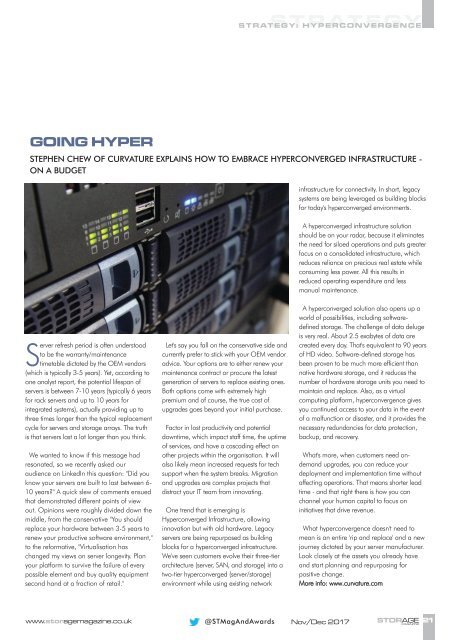ST1711
Create successful ePaper yourself
Turn your PDF publications into a flip-book with our unique Google optimized e-Paper software.
STRATEGY<br />
STRATEGY: HYPERCONVERGENCE<br />
GOING HYPER<br />
STEPHEN CHEW OF CURVATURE EXPLAINS HOW TO EMBRACE HYPERCONVERGED INFRASTRUCTURE -<br />
ON A BUDGET<br />
infrastructure for connectivity. In short, legacy<br />
systems are being leveraged as building blocks<br />
for today's hyperconverged environments.<br />
A hyperconverged infrastructure solution<br />
should be on your radar, because it eliminates<br />
the need for siloed operations and puts greater<br />
focus on a consolidated infrastructure, which<br />
reduces reliance on precious real estate while<br />
consuming less power. All this results in<br />
reduced operating expenditure and less<br />
manual maintenance.<br />
Server refresh period is often understood<br />
to be the warranty/maintenance<br />
timetable dictated by the OEM vendors<br />
(which is typically 3-5 years). Yet, according to<br />
one analyst report, the potential lifespan of<br />
servers is between 7-10 years (typically 6 years<br />
for rack servers and up to 10 years for<br />
integrated systems), actually providing up to<br />
three times longer than the typical replacement<br />
cycle for servers and storage arrays. The truth<br />
is that servers last a lot longer than you think.<br />
We wanted to know if this message had<br />
resonated, so we recently asked our<br />
audience on LinkedIn this question: "Did you<br />
know your servers are built to last between 6-<br />
10 years?" A quick slew of comments ensued<br />
that demonstrated different points of view<br />
out. Opinions were roughly divided down the<br />
middle, from the conservative "You should<br />
replace your hardware between 3-5 years to<br />
renew your productive software environment,"<br />
to the reformative, "Virtualisation has<br />
changed my views on server longevity. Plan<br />
your platform to survive the failure of every<br />
possible element and buy quality equipment<br />
second hand at a fraction of retail."<br />
Let's say you fall on the conservative side and<br />
currently prefer to stick with your OEM vendor<br />
advice. Your options are to either renew your<br />
maintenance contract or procure the latest<br />
generation of servers to replace existing ones.<br />
Both options come with extremely high<br />
premium and of course, the true cost of<br />
upgrades goes beyond your initial purchase.<br />
Factor in lost productivity and potential<br />
downtime, which impact staff time, the uptime<br />
of services, and have a cascading effect on<br />
other projects within the organisation. It will<br />
also likely mean increased requests for tech<br />
support when the system breaks. Migration<br />
and upgrades are complex projects that<br />
distract your IT team from innovating.<br />
One trend that is emerging is<br />
Hyperconverged Infrastructure, allowing<br />
innovation but with old hardware. Legacy<br />
servers are being repurposed as building<br />
blocks for a hyperconverged infrastructure.<br />
We've seen customers evolve their three-tier<br />
architecture (server, SAN, and storage) into a<br />
two-tier hyperconverged (server/storage)<br />
environment while using existing network<br />
A hyperconverged solution also opens up a<br />
world of possibilities, including softwaredefined<br />
storage. The challenge of data deluge<br />
is very real. About 2.5 exabytes of data are<br />
created every day. That's equivalent to 90 years<br />
of HD video. Software-defined storage has<br />
been proven to be much more efficient than<br />
native hardware storage, and it reduces the<br />
number of hardware storage units you need to<br />
maintain and replace. Also, as a virtual<br />
computing platform, hyperconvergence gives<br />
you continued access to your data in the event<br />
of a malfunction or disaster, and it provides the<br />
necessary redundancies for data protection,<br />
backup, and recovery.<br />
What's more, when customers need ondemand<br />
upgrades, you can reduce your<br />
deployment and implementation time without<br />
affecting operations. That means shorter lead<br />
time - and that right there is how you can<br />
channel your human capital to focus on<br />
initiatives that drive revenue.<br />
What hyperconvergence doesn't need to<br />
mean is an entire 'rip and replace' and a new<br />
journey dictated by your server manufacturer.<br />
Look closely at the assets you already have<br />
and start planning and repurposing for<br />
positive change.<br />
More info: www.curvature.com<br />
www.storagemagazine.co.uk<br />
@STMagAndAwards Nov/Dec 2017<br />
^<br />
STORAGE<br />
MAGAZINE<br />
21

















